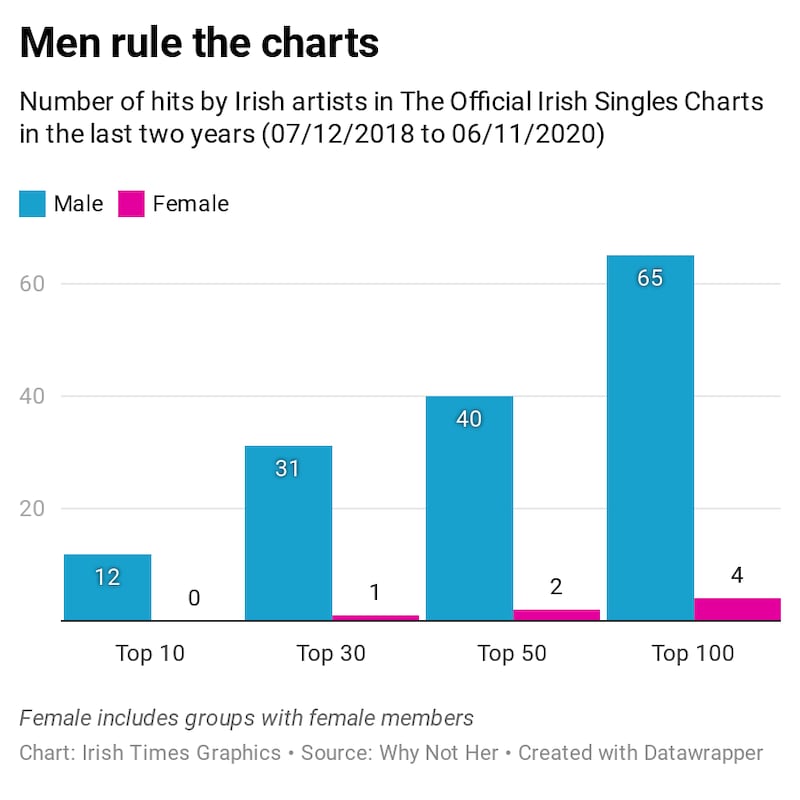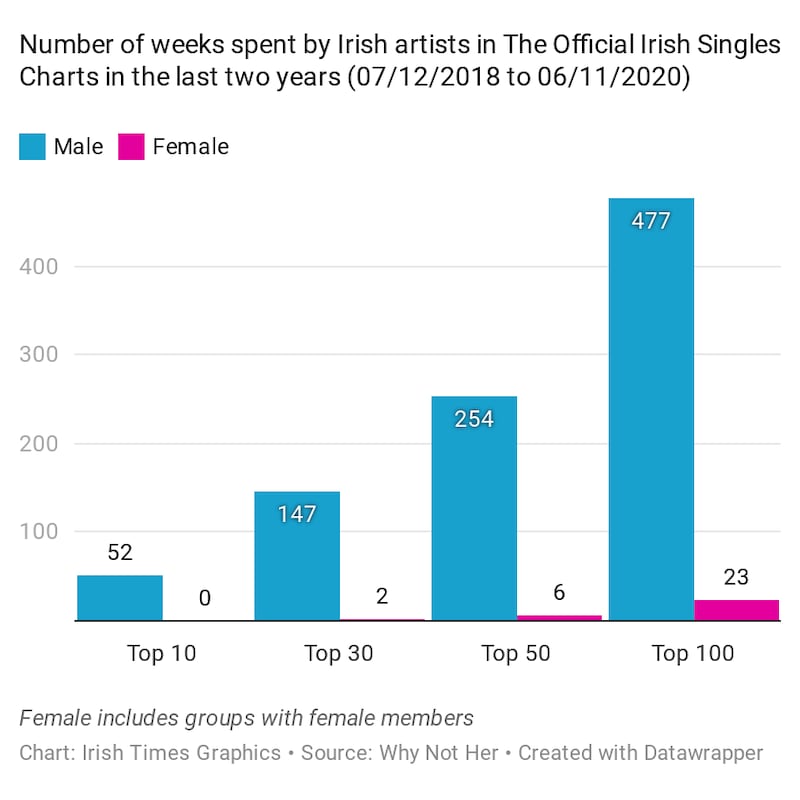In the past two years, no songs by Irish women artists or groups with female members have appeared in the top 10 Irish singles charts, according to a new report on gender and diversity in the music scene, and less than a quarter of albums in the top 100 chart were by Irish women.
In contrast, 12 songs by five Irish male acts spent a total of 51 weeks in the top 10 Irish singles charts across the same time period. Eleven songs by Dermot Kennedy appeared in the top 100 hits over two years; 10 by Picture This; five by Niall Horan; and four each by Westlife, Hozier; and the Coronas.
In the top 100 of the Irish singles charts, 65 songs by Irish men or all-male groups featured, compared with just four by women or female groups: Irish Women in Harmony; Soulé, Ruth-Anne; and Lea Heart.


Among the top 100 album charts in Ireland, 56 were by men and 17 by women or groups which feature women. For example, the band Lankum, made up of men and women, is included in the figures for women artists. Dermot Kennedy, The Coronas, Westlife, Niall Horan and the Script were among the men in the top 100; The Cranberries, Róisín Murphy, Walking on Cars and Sibéal were among the women.
The data from the weekly official Irish singles and albums charts, compiled by the Official Charts Company for the Irish Recorded Music Association, appears in research carried out by DJ, podcast host and activist Cian Sullivan, under the supervision of music consultant and gender activist Linda Coogan Byrne. Coogan Byrne, as part of the campaign group Why Not Her, has released a number of reports looking at gender representation on radio playlists in Ireland and the UK.
Coogan Byrne believes there is an unconscious bias among DJs and radio playlist compilers affecting the number of plays music by a female artist receives.
“If you look at those who compile the playlists [on Irish radio], it’s very homogenised – it’s white men. There are a small handful of women behind the scenes. If we have a music industry orientated by white men, this is what you get.
“I’ve spoken to a lot of the DJs, playlisters, and they argue it’s just what’s doing well in the charts or streaming… but that’s not true.”
She points to Irish female artists, including Orla Gartland and RuthAnne Cunningham as examples, who have high streaming figures, but who receive little radio play. Cunningham performs in her own right, but has also written songs for John Legend, Britney Spears, JoJo, Niall Horan, One Direction and Westlife; one track she co-wrote for Legend has been nominated for a Grammy.
“Radio stations say they’re looking at streaming, but that’s not true,” says Coogan Byrne. “If it was, RuthAnne would have been played by them since she started her career. RuthAnne can write songs, record them, perform them, but she also produces, mixes and masters – a woman on her own.”
The amount of radio play an artist gets, and the position of their songs and albums in charts have a direct correlation to their career trajectory: “If radio breaks an artist, record labels take note,” says Coogan Byrne. Consequently, she says, this also impacts if an artist is booked for a festival, and a result, can affect their financial and career success.
Earlier this year, a series of reports by Coogan Byrne into gender representation in music played on Irish radio stations presented a mixed, but changing picture. RTÉ Radio 1 was the only station to consistently split their top 20 tracks between male and female artists; while just 10 per cent of Today FM's top 20 tracks were by female artists.
Spin 103.8 increased their gender parity across the year from 35 to 40 per cent; 98FM went from 10 to 20 per cent; and FM104 increased from zero to 10 per cent.



















